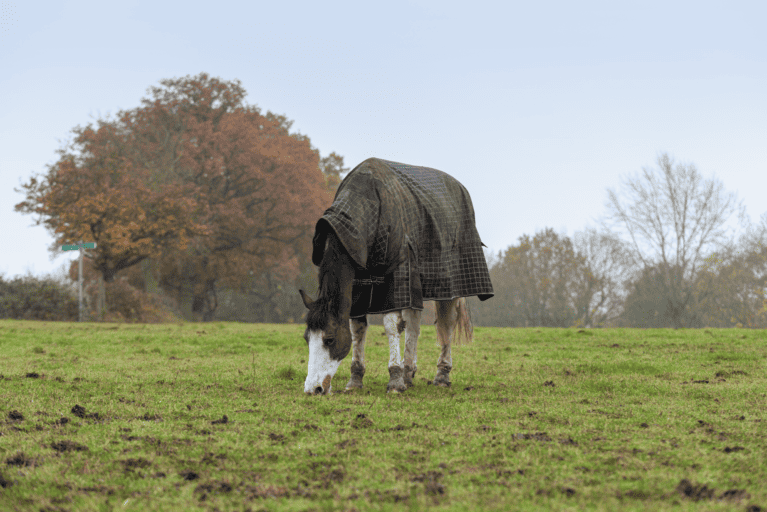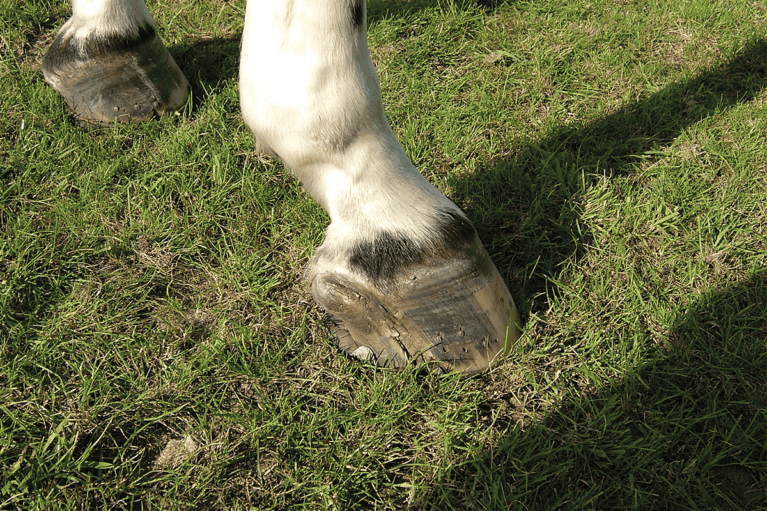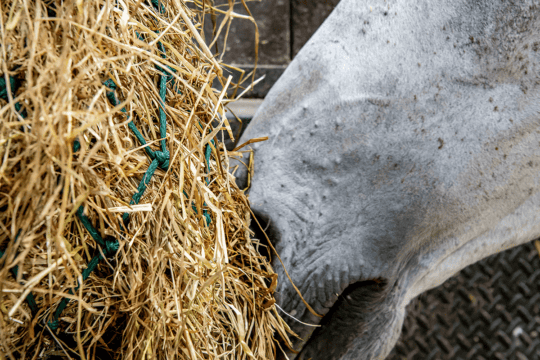While abscesses can occur anywhere in the body, you’re most likely to come across this form of bacteria build-up in the hoof. Vet Andrew Robinson explains more

Every day we’re surrounded by trillions of bacteria. They’re found everywhere, from the soil to the sea, and some live in or on other organisms, such as horses. A lot of these line the digestive system, playing an essential role in the breakdown and absorption of food. However, there are instances where bacteria aren’t so beneficial – and these might lead a horse to develop an abscess. Let’s find out a little more about those…
When bacteria go bad
A few bacteria, such as Staphylococcus aureus, are pathogens, which cause disease in animals and plants and, alongside yeasts and fungi, can break through the outer surfaces of your horse’s body and enter places where they’re not supposed to be – such as the skin or foot.
The horse will respond to this attack by activating his defence mechanism – the immune system – which has white blood cells (leukocytes) to attack the invading organism. An accumulation of the intrusive bacteria, white blood cells and dead cells form a thick, foul-smelling material commonly called pus that often causes the area to become inflamed as well as looking red and feeling hot.
Did you know?
While some bacteria cause food spoilage and crop damage, others play an essential part in the production of fermented foods, such as yoghurt.
Skin deep
Abscesses can occur in virtually any part of the body. They often affect the skin because it is easily broken by sharp or rough objects, or even or a veterinary surgeon’s scalpel during procedures such as gelding or removing growths, allowing the bacteria to enter. They can also be seen in the mouth if a sharp tooth edge or even object in forage damages the delicate membrane, allowing organisms to enter the cheek skin or tooth roots.
It is possible for abscesses to occur internally in the brain or abdomen, which puts pressure on the adjacent organs – these are much harder to resolve and require intensive treatment, such as intravenous antibiotics and anti-inflammatories.
Abscesses aren’t always straightforward to spot, but there are a few warning signs to look out for…
- there may be a swelling present. These can vary in density from soft and fluid feeling through to hard amd rigid
- the swelling may be warm to the touch and painful causing the horse to not use the affected area
- the area may appear discoloured with the yellowy green or off-white pus visible through the thin capsule of the abscess
- the horse may have a fever and appear off colour, having a reduced or no appetite
- there may be a foul smell if the abscess has started to leak its contents on the hair around the area
Did you know?
There are approximately 10 times as many bacterial cells in or on your horse’s body as horse cells.

Did you know?
If your vet deems the area to be amenable to antibiotics, a course of broad spectrum, systemic (injected, rather than topical) antibiotics may be prescribed. These will cover the most common types of abscess-causing bacteria with the aim of destroying those present in the site.
Treatment of an abscess
The abscess is usually walled off, forming a capsule. Where it’s accessible, the most common treatment is to try and lance it (or, in the case of tooth root abscesses, remove the tooth) to reduce the pressure and amount of infection. The capsule can then be flushed and allowed to drain. This will often bring immediate relief to the patient.
Your vet will advise you whether antibiotics may work for your horse’s abscess. If there’s a thick capsule containing the abscess, lancing and flushing, alongside topical antiseptic treatment, may be sufficient without the need for additional antibiotics. This is partly because walled-off areas often have a poor blood supply to the site of the infection, which means antibiotics may have little effect.
If your vet decides the area is suited to a course of antibiotics, but they don’t have the desired effect, a sterile swab can be taken from the site to find out which bacteria is present. Once this has been grown in the laboratory a number of discs containing the most commonly used antibiotics are placed in the petri dish of bacteria to determine, by seeing which clears the largest area of bacterial growth, which one is the most effective treatment option.
Alongside the antibiotics, pain relief will be given. This will generally be a non-steroidal anti inflammatory drug (NSAID) that will reduce swelling, pain and any fever symptoms.
If the area can be covered then your vet may suggest applying a poultice. This is a moist dressing soaked in warm water and some topical antimicrobial agent, which works by drawing out toxins and dirt from the abscess to encourage increased oxygen to the area, and therefore promoting new cell growth.
For abscesses on the body (not the foot) a hot pack can be used (a human one is fine). Wrap the pack in a towel and bandage it against the area of the abscess, ensuring there’s not direct contact between the hot pack and the skin.
Feet first
The most common area for abscesses to develop is in the foot. Hoof abscesses (often called pus in the foot) occur when bacteria enter the sensitive laminae. This is more likely to happen if…
- the laminae are diseased in some way (for example, in horses suffering with EMS or laminitis)
- the sole is damaged – for example, by a sharp object such as broken glass or a nail, or after a bruised sole. This type is called a subsolar abscess
- the hoof is continually exposed to wet, muddy conditions with little or no routine foot care. This can soften the sole and allow bacteria to enter, causing an abscess
Top tip
Lancing an abscess should be done by a vet to avoid catching any adjacent blood vessels or nerves, and ensure the follow-up care is correctly planned.
Signs of a hoof abscess
Abscesses usually only affect one foot (although they can affect more), and often develop very quickly, with the horse appearing fine one day and then very lame the next. Signs to look for that indicate an abscess could be the cause include…
- the horse will be very uncomfortable, even when standing, and may elect to rest the affected foot or toe-point to alleviate pressure
- the pulse at the back of the fetlock will be raised
- the hoof wall may feel warm to the touch
- as the situation progresses the fetlock may start to feel puffy and swollen
A horse suffering with an abscess may also present or be reported as lame and then appear totally sound the next day. A few days later however, he might present as more severely lame, which is often a classic history when it comes to foot abscesses. This waxing and waning of pain is related to the pus moving around within the cavities of the foot. When there’s a build-up of pressure, there’s pain and an obvious lameness to the owner. If the pressure is released by the pus moving into a different cavity, owners can then find the lameness presents as less until the infection builds up again.
Did you know?
Even with regular foot care, hoof abscesses may not be noticeable until the horse goes very lame.
Diagnosing an abscess
When your vet examines your horse, they’ll determine whether an abscess is the cause of the lameness or whether there’s another cause, such as a bruised sole, laminitis or pedal bone fracture.
One of the first steps is to use hoof testers to gently apply pressure around the white line (the soft area where the internal structures of the foot attach to the hoof wall via a series of finger-like projections called laminae). The hoof testers help to identify whether an abscess is the cause of the lameness and, if so, help localise where it is. At this point a small, sharp hoof knife can be used to lance the abscess and release as much of the pus as possible.
Most abscesses are uncomplicated and should heal in 7–10 days. However, if they aren’t quickly diagnosed and the pus builds up within the foot, it can create a much larger abscess. As it spreads out, pus will always track to a point of least resistance, which, with a solid hoof wall preventing it from bursting outwards, means it will need to find a way to exit the hoof cavity by tracking upwards to the coronary band or heel. These abscesses take longer to resolve and mean more tissue needs to be opened up to allow healing. Pain relief will be needed until the abscess bursts out at the coronary band.
Another outcome can be that the pus tracks inwards and affects the bones in the foot, causing a septic pedal bone. This is a very serious complication and requires urgent, significant veterinary attention in a clinic setting.
Poulticing an abscess
Once the abscess has burst or been lanced a poultice is applied. This will draw out infection and keep the area clean, helping prevent further reinfection. Modern poultice dressings contain boric acid and tragacanth, which work as an antiseptic and help draw out the pus. They can be applied using hot or cold water. A wet poultice (the most common way to apply) is more effective at drawing fluid out, but a dry poultice can work well if an abscess has a lot of fluid coming out. The poultice should be applied with the plastic coating facing away from the abscess site, and then be covered with cushioning material, conforming bandage and an external waterproof layer. If a lot of pus is discharging the dressing should be changed twice a day, but often once a day is enough. A wet poultice should be used for two to three days and then a dry one used to cover the area and prevent any further dirt entering. The foot can also be tubbed – this is done by standing the horse with his hoof in warm water saturated with Epsom salts (a saturated salt solution is when there are undissolved salts on the bottom of your container) prior to applying the poultice to encourage the pus to come out.
Preventing abscesses
As long as there are no underlying pathological conditions that predisposed the horse to experience an abscess in the first place, generally there should be no long-term complications. Once the abscess has healed, if the horse is shod then the shoe can be replaced. However, if the shoe is put on too soon, the abscess might reoccur.
Sadly there’s nothing that can be done to completely eliminate a horse from the risk of developing an abscess. Good stable hygiene and maintaining sanitary conditions and giving prompt first aid to any injuries will minimise the chance that an abscess may occur. It’s also important to seek quick veterinary attention if you suspect an abscess may be present.
In the case of hooves, regular trimming can reduce the incidence of pus in the foot, as well as a good diet supplying the basic nutrients required for healthy hooves and a good immune system. If hooves are poor, supplements can be used to improve their quality – these should include biotin, methionine and zinc.
Our expert – Andrew Robinson BSc (Hons) BVMS MRCVS qualified from Glasgow Veterinary School over 20 years ago and has since worked in mixed practice. He joined Millcroft Veterinary Group in 2003 and a few years later entered the partnership, taking particular responsibility for the equine side.















